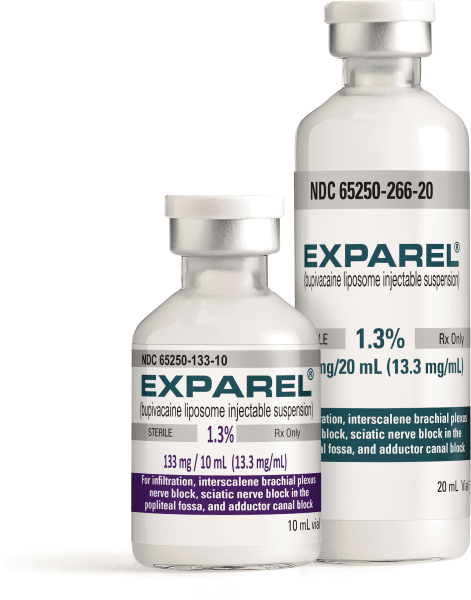Exparel Drug Interactions
Currently displaying a list of 129 drugs known to interact with Exparel (bupivacaine liposome).
- 23 major drug interactions
- 104 moderate drug interactions
- 2 minor drug interactions
Medications known to interact with Exparel
Note: Showing generic names only.
A
B
C
- carteolol
- carteolol ophthalmic
- carvedilol
- celecoxib
- chlordiazepoxide
- chloroprocaine
- chloroprocaine ophthalmic
- chloroquine
- ciprofloxacin
- cisatracurium
- clobazam
- clonazepam
- clorazepate
- cocaine nasal
- cocaine topical
- cyclophosphamide
D
E
F
H
I
K
L
- labetalol
- landiolol
- levobetaxolol ophthalmic
- levobunolol ophthalmic
- levobupivacaine
- lidocaine
- lidocaine ophthalmic
- lidocaine otic
- lidocaine topical
- lorazepam
M
- mafenide topical
- mepivacaine
- metipranolol ophthalmic
- metoclopramide
- metocurine
- metoprolol
- mexiletine
- midazolam
- mivacurium
- moricizine
N
O
P
- pancuronium
- penbutolol
- phenazopyridine
- phenobarbital
- phenytoin
- pindolol
- pipecuronium
- povidone iodine topical
- pramoxine topical
- prilocaine
- primaquine
- procainamide
- procaine
- procaine penicillin
- propafenone
- proparacaine ophthalmic
- propranolol
Q
R
S
- silver nitrate topical
- silver sulfadiazine topical
- sodium nitrite
- sotalol
- succinylcholine
- sulfadiazine
- sulfamethizole
- sulfamethoxazole
- sulfasalazine
- sulfisoxazole
T
- tafenoquine
- temazepam
- tetracaine
- tetracaine ophthalmic
- tetracaine topical
- tilmanocept
- timolol
- timolol ophthalmic
- tocainide
- trazodone
- triazolam
- trimethoprim
- tubocurarine
V
Exparel disease interactions
There are 3 disease interactions with Exparel (bupivacaine liposome) which include:
More about Exparel (bupivacaine liposome)
- Exparel consumer information
- Check interactions
- Compare alternatives
- Pricing & coupons
- Reviews (76)
- Drug images
- Side effects
- Dosage information
- During pregnancy
- FDA approval history
- Drug class: local injectable anesthetics
- En español
Related treatment guides
Drug Interaction Classification
| Highly clinically significant. Avoid combinations; the risk of the interaction outweighs the benefit. | |
| Moderately clinically significant. Usually avoid combinations; use it only under special circumstances. | |
| Minimally clinically significant. Minimize risk; assess risk and consider an alternative drug, take steps to circumvent the interaction risk and/or institute a monitoring plan. | |
| No interaction information available. |
See also:
Further information
Always consult your healthcare provider to ensure the information displayed on this page applies to your personal circumstances.


